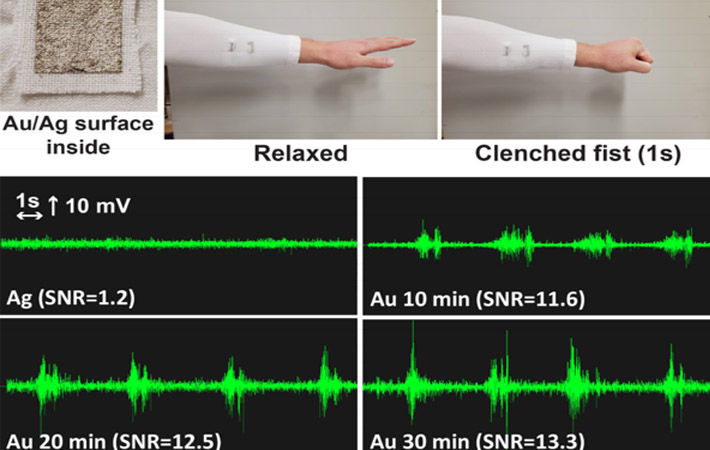
This new technology was recently detailed in a paper published in the science journal, APL Materials. The paper titled “Gold and silver nanocomposite-based biostable and biocompatible electronic textile for wearable electromyographic biosensors,” was co-authored by University of Utah chemical engineering graduate student, Taehwan Lim, and Sohee Lee from the department of clothing and textiles at Gyeongsang National University in South Korea.
Zhang and his team have devised a method of taking ordinary textile made of a cotton/polyester blend and turning the fabric into sensors that measure electrical impulses generated from muscle movement. This could become a much better solution in measuring muscle activity for physical rehabilitation or for other medical applications. Ordinarily, current bioelectrical sensor technology in which they tape sensors with wires to the skin can sometimes be ineffective, uncomfortable, expensive, and costly to manufacture, the university said in a press release.
“This new method can enable clinicians to collect a muscle’s long-term electrical signals with more precision. And we can get a better understanding of a patient’s progress and therefore their therapeutic outcomes over time,”said assistant professor Huanan Zhan.
When human muscle contracts, it emits electrical signals in the form of ions (as opposed to electrons from an electrically powered device). Zhang’s process involves depositing a microscopic layer of silver over a piece of fabric to make the material conductive and therefore receive the electrical signal from the muscle.
But having just a layer of silver is a problem since the metal can be somewhat toxic when in prolonged contact with the skin. So the researchers also deposit a second microscopic layer of gold, which is non-toxic to the touch. The gold not only protects the skin from the silver, but it also enhances the electrical signal, Zhang explained.
“The silver layer provides a baseline conductivity, but the gold on top improves the signal and the biocompatibility, and it helps reduces the cost of manufacturing pure gold devices,” he said.
The silver layer is applied to the fabric in a process similar to screen printing a graphic onto a T-shirt, and it’s applied to just the areas of the clothing that touch the muscle being measured. Then the gold layer is deposited by an electrochemical method. The patches of sensors are then attached to wires and a portable electromyography (EMG) device that measures muscle contractions.
Fibre2Fashion News Desk (RR)

